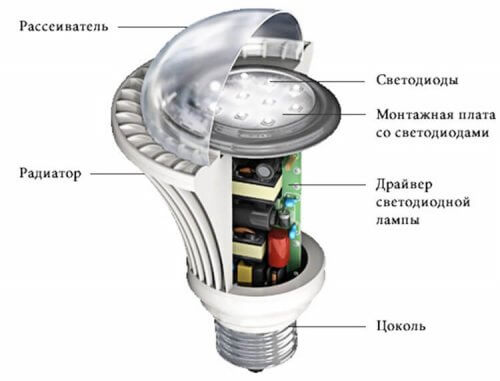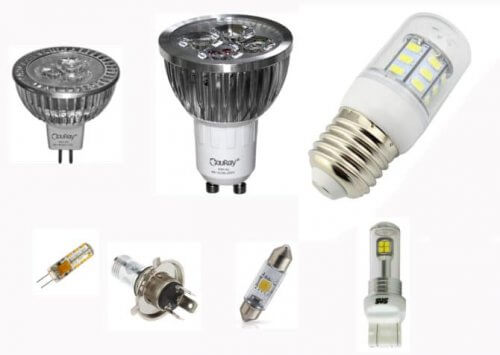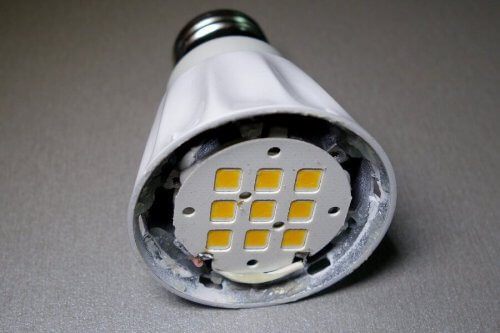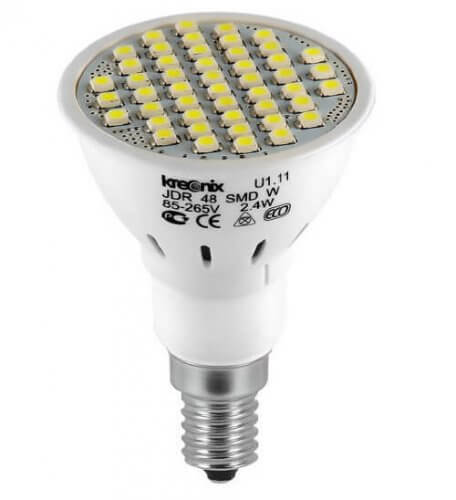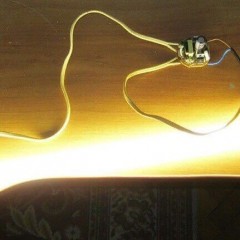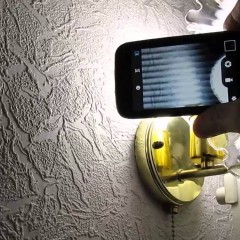How the LED lamp works and how it works
LED lamp device
Users who want to get acquainted with what it is will have to understand the design and principle of operation of the LED bulb. First of all, the classic LED lamp is a prefabricated device consisting of the following main components (photo below):
- Several LED emitters placed on a heat sink aluminum substrate (radiator).
- Matte dome-shaped diffuser, the design of which ensures uniform distribution of the light flux.
- An electronic converter (driver) supplying LEDs with power of the desired quality.
- Standard base (E14, E 27, E 40 and other types).
Important! In the simplest models of bulbs from a Chinese manufacturer, one powerful LED can be installed.
When considering various options for the implementation of LED bulbs, it is important to learn to distinguish them by the magnitude of the supply voltage.
Operating principle
The principle of operation of a light bulb on LEDs is presented as a series of transformations that ensure the glow of the emitters included in its composition. When supplying voltage to the base, it first goes to the driver, the purpose of which is precisely to bring the high voltage to a form acceptable for LED lamps.
To briefly describe this method of energy supply, it is enough to refer to the following scheme:
In simple words - her work can be represented as follows:
- First, an alternating voltage is applied to diode bridgewhere it is partially straightened.
- The following electrolytic capacitance is designed to smooth out pulsations.
- After that, a fully rectified voltage is supplied to the controller that controls the operation of the LED lamp.
- From the electronic module, it goes directly to the LEDs through an isolation pulse transformer.
Important! When answering a frequently asked question: why is this isolation necessary? Let us answer - its presence partially reduces the risk of high voltage damage when working with the lamp base.
The principle of operation of a 12-volt LED bulb is much simpler, since a typical power supply will be required to convert the voltage and nothing else. And this, ultimately, reduces the cost of the entire product as a whole.
Differences in Type of Nutrition
In accordance with this parameter, the known samples of LED lamps are divided into the following modifications:
- with LEDs rated for 220 volts.
- working from low and rectified voltage of 12 volts.
The first light sources in this list operate in typical power grids and turn on like ordinary incandescent lamps.
LED lamps designed for 12 volts DC, due to the low voltage and a wide selection of socles, are universal products.
For the operation of such lamps, a special power supply will be required that reduces the ac mains voltage to a constant value of 12 volts.
Application area
When considering where LED lamps are used, a separate approach to different designs will be required. Products that are directly connected to the 220 Volt network are operated as ordinary lamps (fluorescent or incandescent) with the corresponding base. In contrast, low-voltage LED illuminators are used for a variety of purposes, ranging from spot lighting in the arrangement of stretch ceilings and ending with the organization of exterior and interior lighting. Individual samples are positioned as car bulbs, installed in most models of modern vehicles.
Important! The relatively low voltage supply provides LED lamps with high electrical and fire safety (eliminates electric shock and fire).
These advantages allow us to expand the scope of LED bulbs and install low-voltage models in the following situations:
- In rooms of high humidity (for example, when arranging LED backlight bathroom mirrors).
- In conditions of high fire and explosion hazard.
- When arranging lights of various kinds.
- In warehouses and basements.
- On the street under the open sky.
In the latter case, such lamps can be operated without special protection measures and the use of wiring with increased requirements for insulation reliability.
note: The versatility of LED lamps is emphasized by the fact that they often use a module from LED strip lights as a power supply.
However, for reliable operation of low-voltage lamps, it is best to use a specialized 12-volt power supply, designed to work with LEDs.
Types of lamps and their quality assessment
From a technical point of view, all considered LED lamps differ in the following indicators:
- Type of power (220 or 12 volts).
- Base Type.
- The number of LEDs.
- Lighting power (luminous flux).
- Body shape.
According to the design features that affect the reliability of this sample and its cost, LED bulbs are divided into branded products and cheap Chinese samples. The latter of them have a simpler device and are not very reliable.
The design differences of branded products from Chinese consumer goods are manifested in such details as the presence of a “powerful” heat dissipation and high-quality designed diffuser and base.
Any LED lamp on the market is viewed by the user in two ways: from the point of view of its reliability (quality) and from the point of view of purchase costs. With this approach to the purchase of lighting fixtures, the choice remains with the buyer. In conclusion, we note that the LEDs allow in practice to implement the principle of energy saving in the home. Thanks to the features of their device and functioning, it is possible to save part of the funds spent on lighting needs.
Now you know what an LED lamp is, how it is arranged and how it works. We hope that the information provided was understandable and useful for you!
Related materials:

